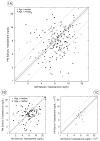Seasonal and circadian variation in salivary testosterone in rural Bolivian men
- PMID: 19367574
- PMCID: PMC3771338
- DOI: 10.1002/ajhb.20927
Seasonal and circadian variation in salivary testosterone in rural Bolivian men
Abstract
Testosterone (T) plays a key role in the increase and maintenance of muscle mass and bone density in adult men. Life history theory predicts that environmental stress may prompt a reallocation of such investments to those functions critical to survival. We tested this hypothesis in two studies of rural Bolivian adult men by comparing free T levels and circadian rhythms during late winter, which is especially severe, to those in less arduous seasons. For each pair of salivary T(AM)/T(PM) samples (collected in a approximately 12-h period), circadian rhythm was considered classic (C(CLASSIC)) if T(AM) > 110%T(PM), reverse (C(REVERSE)) if T(PM) > 110%T(AM), and flat (C(FLAT)) otherwise. We tested the hypotheses that mean T(AM) > mean T(PM) and that mean T(LW) < mean T(OTHER) (LW = late winter, OTHER = other seasons). In Study A, of 115 T(PM)-T(AM) pairs, 51% = C(CLASSIC), 39% = C(REVERSE), 10% = C(FLAT); in Study B, of 184 T(AM)-T(PM) pairs, 55% = C(CLASSIC), 33% = C(REVERSE), 12% = C(FLAT). Based on fitting linear mixed models, in both studies T(OTHER-AM) > T(OTHER-PM) (A: P = 0.035, B: P = 0.0005) and T(OTHER-AM) > T(LW-AM) (A: P = 0.054, B: P = 0.007); T(PM) did not vary seasonally, and T diurnality was not significant during late winter. T diurnality varied substantially between days within an individual, between individuals and between seasons, but neither T levels nor diurnality varied with age. These patterns may reflect the seasonally varying but unscheduled, life-long, strenuous physical labor that typifies many non-industrialized economies. These results also suggest that single morning samples may substantially underestimate peak circulating T for an individual and, most importantly, that exogenous signals may moderate diurnality and the trajectory of age-related change in the male gonadal axis.
Figures


Similar articles
-
Circadian variation in salivary testosterone across age classes in Ache Amerindian males of Paraguay.Am J Hum Biol. 2010 Mar-Apr;22(2):216-20. doi: 10.1002/ajhb.21012. Am J Hum Biol. 2010. PMID: 19957265
-
Cortisol and testosterone in Filipino young adult men: evidence for co-regulation of both hormones by fatherhood and relationship status.Am J Hum Biol. 2011 Sep-Oct;23(5):609-20. doi: 10.1002/ajhb.21187. Epub 2011 Jun 2. Am J Hum Biol. 2011. PMID: 21638512
-
Greater thermoregulatory strain in the morning than late afternoon during judo training in the heat of summer.PLoS One. 2020 Dec 1;15(12):e0242916. doi: 10.1371/journal.pone.0242916. eCollection 2020. PLoS One. 2020. PMID: 33259509 Free PMC article.
-
Interactions of cortisol, testosterone, and resistance training: influence of circadian rhythms.Chronobiol Int. 2010 Jun;27(4):675-705. doi: 10.3109/07420521003778773. Chronobiol Int. 2010. PMID: 20560706 Review.
-
Illustrations of interactions needed when investigating sleep using a type of AM-PM PM-AM design.Psychon Bull Rev. 2023 Dec;30(6):2106-2115. doi: 10.3758/s13423-023-02248-8. Epub 2023 Jun 15. Psychon Bull Rev. 2023. PMID: 37322385 Free PMC article. Review.
Cited by
-
Effects of seasonal differences in testosterone and cortisol levels on pain responses under resting and anxiety conditions.Yonsei Med J. 2014 Jan;55(1):216-23. doi: 10.3349/ymj.2014.55.1.216. Yonsei Med J. 2014. PMID: 24339310 Free PMC article. Clinical Trial.
-
Designing mental health interventions informed by child development and human biology theory: a social ecology intervention for child soldiers in Nepal.Am J Hum Biol. 2015 Jan-Feb;27(1):27-40. doi: 10.1002/ajhb.22651. Epub 2014 Nov 7. Am J Hum Biol. 2015. PMID: 25380194 Free PMC article.
-
Energetic costs of testosterone in two subsistence populations.Am J Hum Biol. 2023 Nov;35(11):e23949. doi: 10.1002/ajhb.23949. Epub 2023 Jun 26. Am J Hum Biol. 2023. PMID: 37365845 Free PMC article.
-
Factors Influencing the Use of Biomedical Health Care by Rural Bolivian Anemic Women: Structural Barriers, Reproductive Status, Gender Roles, and Concepts of Anemia.PLoS One. 2017 Jan 26;12(1):e0170475. doi: 10.1371/journal.pone.0170475. eCollection 2017. PLoS One. 2017. PMID: 28125636 Free PMC article.
-
Minimally invasive biomarkers in human and non-human primate evolutionary biology: Tools for understanding variation and adaptation.Am J Hum Biol. 2022 Nov;34(11):e23811. doi: 10.1002/ajhb.23811. Epub 2022 Oct 7. Am J Hum Biol. 2022. PMID: 36205445 Free PMC article.
References
-
- Abbaticchio G, de Fini M, Giagulli VA, Santoro G, Vendola G, Giorgino R. Circannual rhythms in reproductive functions of human males, correlations among hormones and hormone-dependent parameters. Andrologia. 1987;19:353–361. - PubMed
-
- Andersson AM, Carlsen E, Petersen JH, Skakkebaek NE. Variation in levels of serum inhibin B, testosterone, estradiol, luteinizing hormone, follicle-stimulating hormone, and sex hormone-binding globulin in monthly samples from healthy men during a 17-month period: possible effects of seasons. J Clin Endocrinol Metab. 2003;88:932–937. - PubMed
-
- Axelsson J, Ingre M, Akerstedt T, Holmback U. Effects of acutely displaced sleep on testosterone. J Clin Endocrinol Metab. 2005;90:4530–4535. - PubMed
-
- Baker HW, Burger HG, de Kretser DM, Hudson B, O’Connor S, Wang C, Mirovics A, Court J, Dunlop M, Rennie GC. Changes in the pituitary testicular system with age. Clin Endocrinol. 1976;5:349–372. - PubMed
-
- Beall CM, Worthman CM, Stallings J, Strohl KP, Brittenham GM, Barragan M. Salivary testosterone concentration of Aymara men native to 3600 m. Ann Hum Biol. 1992;19:67–78. - PubMed
Publication types
MeSH terms
Substances
Grants and funding
LinkOut - more resources
Full Text Sources
Other Literature Sources

